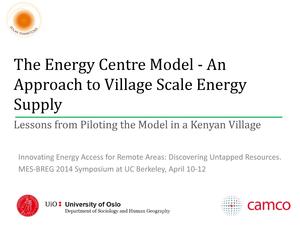Knowledge fuels change - Support energypedia!
For over 10 years, energypedia has been connecting energy experts around the world — helping them share knowledge, learn from each other, and accelerate the global energy transition.
Today, we ask for your support to keep this platform free and accessible to all.
Even a small contribution makes a big difference! If just 10–20% of our 60,000+ monthly visitors donated the equivalent of a cup of coffee — €5 — Energypedia would be fully funded for a whole year.
Is the knowledge you’ve gained through Energypedia this year worth €5 or more?
Your donation keeps the platform running, helps us create new knowledge products, and contributes directly to achieving SDG 7.
Thank you for your support, your donation, big or small, truly matters!
The Energy Centre Model - An Approach to Village Scale Energy Supply
The Energy Centre Model - An Approach to Village Scale Energy Supply
Presenter: Charles Muchunku, (Camco Advisory Services (K) Ltd, Kenya)
Overview
| A model for off-grid, village scale power supply has been developed through the Solar Transitions research project, led by the University of Oslo. Through a participatory approach the project developed an energy centre model which became operational on March 20th, 2012. The model creates affordable and accessible basic lighting and electricity services for off-grid households and businesses through a financially sustainable design. It is designed to be operated by local residents on commercial principles. Today, it provides lighting and other services to about 150 households. The paper describes and rationalizes the model and shares experiences from the first 1½ years of operation. The financial performance is documented and suggestions are provided on how the model could be improved[1].
|
Issues Presented
► Please see the presentation.
- Rural regions, 80% 0f population lives on 20% of the land
- The converse of this is that 20% of the project is on 80% of the land
- This means low population density
- Mini-grid is not a viable model
- There are simply not the numbers of people
- Thus a 2kW system was decided upon- Charging station of sorts
- Issue was how to figure out how to transfer ownership after the payback period
- Incorporated a Community Based Org (CBO)
- They got some community buy in, by charging a fee to become a member
- Institutional and Operations Framework: They had a bookkeeper, Technician,IT manager (for photocopying, computers, etc.)
- The organization in charge was community based
- They were charged with managing. If they did poorly, they were required to surrender the system and give it to someone else
- Results:
- Initially, things were slow
- People felt cheated for not being able to exploit full charge
- The issue was explained--the deal with saving the batteries--and translated into more user-ship
- Some services were being subsidized by other
Q & A
1. What is the IRR for sharing with investors?
- This is not the approach that was used.
2. Is there any interest in creating a cell phone specific application?
- No. The cost, even for a simple SHS system is cost restrictive.
References
- ↑ The Energy Centre Model - An Approach to Village Scale Energy Supply. Charles Muchunku and Kirsten Ulsrud)





















